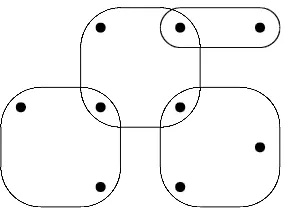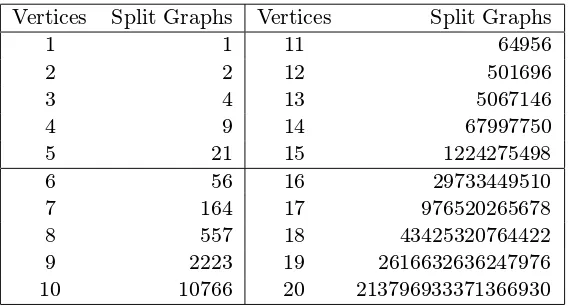23 11
Article 00.2.6
Journal of Integer Sequences, Vol. 3 (2000),
23 6 1 47
Counting Set Covers and Split Graphs
Gordon F. Royle
Department of Computer Science University of Western Australia
and
Department of Combinatorics and Optimization University of Waterloo
Email address: [email protected]
Abstract
A bijection between split graphs and minimal covers of a set by subsets is presented. As the enu-meration problem for such minimal covers has been solved, this implies that split graphs can also be enumerated.
1 Motivation
Asplit graphis a chordal graph with a chordal complement. It is straightforward to recognize split graphs, and therefore to compute the numbers of split graphs on a small number of vertices, as shown in Table1. Whenever such a table is given, it is to be understood that they contain numbers of pairwise non-isomorphic objects, rather than ‘labeled’ objects. The numbers in Table 1 form sequence A48194 in [5], which is an online database of interesting sequences of integers (see also [4]). One of the aims of this database is to permit researchers who encounter a sequence to deter-mine whether it has occurred before, and in what context, thereby exposing possibly unexplored connections.
Ak-cover of ann-setN is a collection ofksubsets ofN whose union isN. Ak-cover isminimal if no sub-collection also coversN. Clarke [1] gives an expression for the number of minimalk-covers of an n-set (where again it is to be understood that the numbers refer to the number of pairwise non-isomorphic objects). Using this formula, Michael Somos (private communication) computed the total number of minimal covers of an n-set and using [5] observed that for n ≤11 (the limit of the sequence known at that time), this number was equal to the number of split graphs on n
vertices.
1.1Theorem. There is a one-one correspondence between the split graphs on nvertices and the minimal covers of a set of sizen.
Vertices Split Graphs
1 1
2 2
3 4
4 9
5 21
6 56
7 164
8 557
9 2223
10 10766
11 64956
12 501696
Table 1: Split graphs on small numbers of vertices
2 Background
In this paper, a graph means an undirected graph without multiple edges or loops. For basic graph theory terminology and background, the books of Diestel [2] and West [6] are recommended.
A graph is chordal (or triangulated) if it has no cycle of length 4 or greater as an induced subgraph. Chordal graphs form an important class of graphs, and have been extensively studied, particularly with respect to determining the complexity of a wide range of problems known to be NP-hard for general graphs. A split graphis a chordal graph with a chordal complement; this terminology arises because a graphXis a split graph if and only if there is a partitionV(X) =I∪C
where I is an independent set and C a clique (see Foldes & Hammer [3]). Thus X can be ‘split’ into a clique and an independent set—a splitV(X) =I∪C will be called specialif every vertex in
C is adjacent to at least one vertex in I. Every split graph has a special split, because if there is a vertex inC not adjacent to any element ofI, it can be moved to I.
In general a k-cover of an n-set may include both empty sets and multiple occurrences of a subset. Thek-covers S1 of N1 andS2 of N2 are isomorphic if there is a bijectionφ:N17→N2 such
thatφ(S1) =S2. Clarke [1] considers several enumeration problems for k-covers. He encompasses
the situations where the cover is ordered or unordered, minimal or not-necessarily minimal and counting is done both by total numbers or numbers of isomorphism classes. However we will only need to use the number of isomorphism classes of minimal covers—what Clarke terms ‘minimal disordered unlabeled covers’. Figure1shows a minimal 4-cover of a 9-set—in a manner analogous to drawing a graph it represents an isomorphism class, rather than a ‘labeled’ cover.
Given a cover S ={S1, . . . , Sk}, we define an elementa∈N to beloyal if it lies in only one of
☎ ☎
Figure 1: A minimal 4-cover of a 9-set
✆
In this section we present a bijection between split graphs on n vertices and minimal covers of a set of size n.
Given a minimal coverS ={S1, . . . , Sk}of a set N, form a graphX=X(S) with vertex setN
as follows. Let I ⊆V(X) be a set obtained by choosing (arbitrarily) one loyal element from each set Si. Let X be the graph whose edge set is the union of a clique on each of the sets Si and a
clique on V(X)\I. It is straightforward to verify that a different choice for the subset I does not alter the isomorphism class of X. Figure 2shows the graph that arises from the cover of Figure 1.
3.2Lemma. IfS is a minimal cover, then the graph X =X(S) defined above is a split graph.
Proof. As a loyal element belongs to one subsetSi, it follows thatI is an independent set of
X. By definitionV(X)\I is a clique, and therefore X is a split graph.
Now, given a split graph X, form a cover S =S(X) of V(X) as follows. Let Mbe the set of maximal cliques ofX. Define a maximal cliqueM ∈ Mto beessentialif there is a vertexv∈V(X) that lies only inM. Then take S to be the set of essential maximal cliques of X.
3.3Lemma. IfX is a split graph, then the cover S=S(X) defined above is a minimal cover.
and henceS is a minimal cover.
3.4Theorem. There is a one-one correspondence between split graphs onnvertices and minimal covers of an n-set.
Proof. If X is a split graph with special split V(X) = I ∪C, then in the cover S(X), the vertices of I form a collection of loyal elements one from each subset in S(X). It follows that
X=X(S(X)) and therefore the two mapsX7→S(X) and S7→X(S) are inverses.
4 Enumeration
We can now provide a formula for counting split graphs onnvertices, using Clarke’s formulas. The first step is to obtain an expression for the number of isomorphism classes of all (not necessarily minimal) k-covers of an n-set. This involves a double summation over all partitions of n and k. Denote the set of all partitions ofnbyPn. A partitionα∈ Pnis given by a sequence [α1, α2, . . . , αm]
Clarke [1] shows that the number of isomorphism classes ofk-covers of an n-set is given by
t(n, k) = 1
and the number of isomorphism classes of minimalk-covers of an n-set is
m(n, k) =t(n−k, k).
Therefore, if s(n) is the number of split graphs onnvertices,
s(n) =
I would like to thank Michael Somos for letting me know of his observation, and Neil Sloane for making it possible.
This research was supported in part by funds from an NSERC operating grant.
References
[1] Clarke, R. J. Covering a set by subsets. Discrete Math. 81, (1990), 147–152.
Vertices Split Graphs Vertices Split Graphs
1 1 11 64956
2 2 12 501696
3 4 13 5067146
4 9 14 67997750
5 21 15 1224275498
6 56 16 29733449510
7 164 17 976520265678
8 557 18 43425320764422
9 2223 19 2616632636247976
10 10766 20 213796933371366930
Table 2: Split graphs on up to 20 vertices
[3] Foldes, St´ephane; Hammer, Peter L. Split graphs,Congressus Numerantium, No. XIX, (1977), 311–315.
[4] Sloane, N. J. A.; Plouffe, Simon. The Encyclopedia of Integer Sequences, Academic Press, 1995.
[5] Sloane, N. J. A. The On-Line Encyclopedia of Integer Sequences. Published electronically at http://www.research.att.com/∼njas/sequences/.
[6] West, Douglas B. Introduction to Graph Theory, Prentice Hall, 1996.
(Concerned with sequenceA48194.)
Received May 3, 2000; published in Journal of Integer Sequences June 6, 2000.


